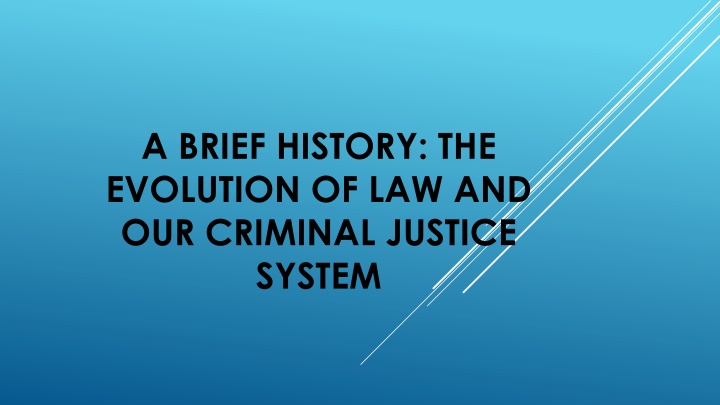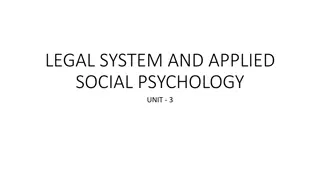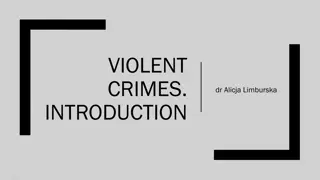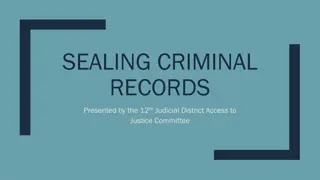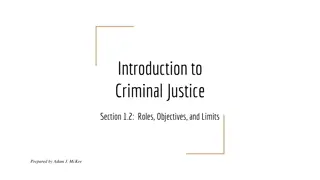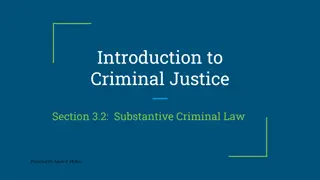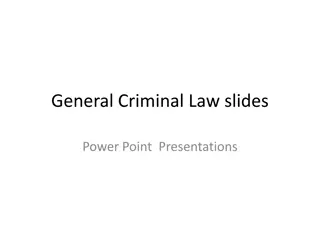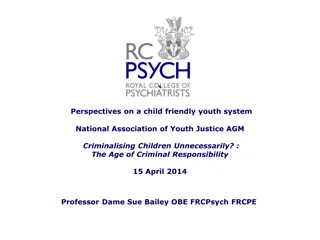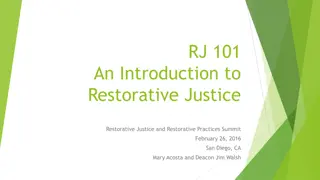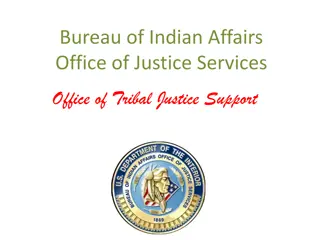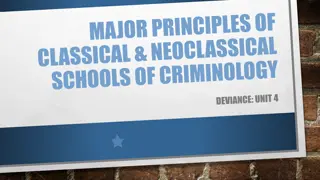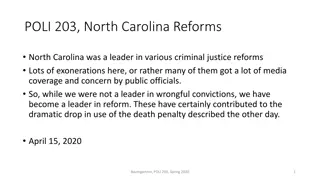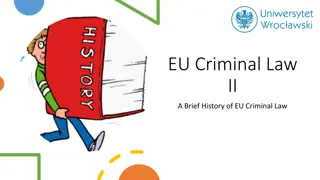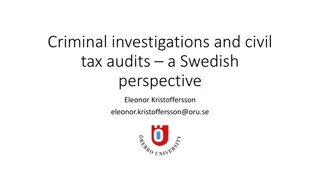The Evolution of Law and Criminal Justice Systems Through History
Law and the criminal justice system have evolved over millennia, starting from primitive and ancient times in Mesopotamia and Babylon to the development of court systems in Egypt, China, Greece, Rome, and England. Each civilization contributed unique elements that shaped the foundations of modern legal frameworks and law enforcement practices.
Download Presentation

Please find below an Image/Link to download the presentation.
The content on the website is provided AS IS for your information and personal use only. It may not be sold, licensed, or shared on other websites without obtaining consent from the author.If you encounter any issues during the download, it is possible that the publisher has removed the file from their server.
You are allowed to download the files provided on this website for personal or commercial use, subject to the condition that they are used lawfully. All files are the property of their respective owners.
The content on the website is provided AS IS for your information and personal use only. It may not be sold, licensed, or shared on other websites without obtaining consent from the author.
E N D
Presentation Transcript
A BRIEF HISTORY: THE EVOLUTION OF LAW AND OUR CRIMINAL JUSTICE SYSTEM
PRIMITIVE AND ANCIENT LAW Began earlier than 2000 BC as a means to control human conduct and enforce society s rules. Keeping the peace was the responsibility of the group. 2300 BC Sumerian rulers set standards on offenses against society. 2400 BC Babylonian king established rules for his kingdom designating offenses and punishment for these offenses.
EGYPT: 1500 BC - The first developing court system around 1500 BC. Court presided by judges appointed by the Pharoah. Around 1000 BC, public officers were performed police functions. Weapon/symbol of authority staff topped by a metal knob engraved with the king s name. May have been the origin of the baton.
CHINA AND EAST ASIA: 771 TO 476 BC Prefecture judicial system: magistrate- appointed government official charged with overseeing the civil administration of respective jurisdictions Tasked with law enforcement and investigative duties; Eventually spread to Japan and Korea; Allowed women to hold positions with the prefect.
GREECE: Ephori form of law enforcement Ephorso five elected unlimited power Duties: investigator, judge, jury and executioner Presided over Senate and Assembly ensuring that their rules and decrees were followed; Punishment should serve a purpose, other than retaliation Plato
ROME 451-450 BC First written laws of Roman Empire The Twelve Tablets Legal procedures, property ownership, building codes, marriage customs and punishment for crimes; Praetorian Guard Protected the Palace Urban Cohort Patrolled the City Vigiles of Rome First civilian police force. Initially were firefighters, later given law enforcement responsibilities. Were ruthless in enforcement vigilante.
ENGLISH LAW AND LAW ENFORCEMENT ANGLO-SAXONS AND TITHING SYSTEM Villages (tribes) self-governing and self-policed. Severe punishment for crimes. Sometimes pay a fine or work off the debt. Innocence could be proven through battle or testimony from other tribe members. Tithing System collective responsibility for maintaining local law and order. Tithing - men enrolled in group of 10 families, unless excused by king. Chief tithingman mayor, council, judge. Two laws enforced: murder and theft. Chief determined innocence or guilty and punishment. Theft usually punished by working off loss through bondage or servitude basis for civil law, restitution for financial loss.
Hue and Cry alarm system, yell out if discover crime, everyone responds to help capture suspect. Possibly origin of general alarm and citizen s arrest. All villages cooperated with each other. Reeve - Head of all chief tithingmen Constable pursuit of law breakers, first English police officer Shire-reeve head of shires (counties), Later Sheriff police officer and judge.
NORMAN FRANKPLEDGE SYSTEM William the Conquerer Norman invader conquered England. Modified tithing system. Established 55 military districts lead by a Norman shire-reeve answered directly to the King. Separated law enforcement and judicial roles. Shire-reeves patrol officers only. Selected own judges who traveled country trying cases (circuit judge)
THE TWELFTH CENTURY King Henry I issued the Leges Henrici crimes committed were against the state and not the victim, i.e. arson, robbery, murder and crimes of violence. Offenses separated into felonies and misdemeanors Law enforcement a public matter. King Henry II established the jury system inquisition required people to give information to a panel of judges, who determined innocence or guilt.
Magna Carta Document that was precedent to democratic government and individual rights; Laid foundation for requiring rulers to uphold the law; forbade taxation without representation; required due process of law, including trial by jury; and provided safeguards against unfair imprisonment; 63 Articles Article 13 restored local control to cities and villages fundamental principle to American law enforcement.
NEXT 500 YEARS King Edward established curfew and night watch program. Watch and Ward local law enforcement provided citizens protection 24 hours a day. Day shift (ward) and night shift (watch). Night shift still referred to as dogwatch . Shire-reeve - replaced by the Justice of the Peace. Parish Constable System rural law enforcement Watch and Ward System urban law enforcement. Riot Act magistrate judge call in military called in to quell a riot.
HENRY FIELDING AND BOW STREET RUNNERS Henry Fielding lawyer, playwright and novelist appointed chief magistrate of Bow Street, London. Fought for social and criminal reform. Bow Street Runners - first detective unit. Successful that other patrols established foot patrols with armed men guarded city s streets and horse patrol of armed men combated highway robbery on main roads.
PEELIAN REFORM Sir Robert (Bobbie) Peel Father of Modern Policing Proposed return to Anglo-Saxon principal of individual community responsibility of preserving law and order; appointed, paid civilians to assume responsibility; and standards for individuals conduct and organization. Organization of the Metropolitan Police of London 1829. Principles were used as basis of police reform in large cities in America. The police are the public and the public are the police .
EARLY LAW IN THE UNITED STATES English colonists brought traditions of law enforcement. Present in early American colonial settlements. Early settlements relied on self-policing. Communal pressure was backbone of law enforcement. New England commerce and industry night watchman or constable for public order. South agriculture sheriff
FIRST U.S. POLICE FORCES Boston -1631 Six man force first Night Watch in U.S. (sunset to sunrise) New York 1643 - Burgher Guard formed to protect colony 1653 name changed to Rattle Watch night patrolling citizens armed with rattles to call for help 30 years later first uniformed police officers 1844 first paid Day Watch implemented with 16 officers. Now had 24 hour patrol, city police force modeled after London s Metropolitan Police.
Los Angeles Sheriff extensive patrol on horseback to protect city from Native Americans and marauding desperados; Marshal deputize citizens to maintain public order; Los Angeles Rangers 100 volunteer police force Los Angeles City Guards volunteer to paid department
POLICE INVESTIGATORS AND DETECTIVES Allan Pinkerton appointed the first detective in Chicago Developed several detective techniques still used today: Stings, undercover work, surveillance method of shadowing and following targets/suspects; Worked on centralized database of criminal identification records now maintained by FBI. Pinkerton National Detective Agency forerunners to the Secret Service.
SLAVE PATROLS Created to control slaves in the Southern states. Enforced the slave code used to regulate slaves. Allowed to enter plantations, break into slave dwellings, search slave persons and possessions at will, and beat/murder if found violating the slave code.
EVOLUTION OF CITY POLICE Face to face, telephone-pole lighting system for call-waiting response, telegraph network to other police stations and patrol officers, bell alarm for slow wagon or fast wagon (emergency), and Gamewell telephone (two way telephone). THE VIGILANTE MOVEMENT Settlers taking law into own hands South Carolina response to outlaws and runaway slaves. Leader usually one of most powerful men in community, making movement respectable.
ESTABLISHMENT OF FEDERAL AGENCIES Department of Justice Attorney General - largest law firm U.S. Attorney s Office Federal Bureau of Investigation (FBI) Drug Enforcement Administration (DEA) U.S. Marshal Service (USMS) oldest federal agency Bureau of Prisons (BOP) Immigration and Naturalization Services (INS) Office of Pardon Attorney Office of Federal Detention Trustee U.S. Parole Commission U.S. National Central Bureau Interpol National Drug Intelligence Center
Department of the Treasury Bureau of Customs (U.S. Customs) Internal Revenue Service (IRS) Secret Service Bureau of Alcohol, Tobacco and Firearms (ATF) OTHER LAW ENFORCEMENT AGENCIES U.S. Postal Inspectors Naval Criminal Investigative Service (NCIS), Coast Guard Investigative Service (CGIS), Air Force Office of Special Investigations (OSI) Federal Protective Service (FPS)
Department of Homeland Security 2002 INS, Secret Service, U.S. Coast Guard and Bureau of Customs Bureau of Citizenship and Immigration Services (BCIS) Bureau of Customs and Border Protection (BCBP) Transportation Security Administration (TSA) Office of Inspector General Federal Computer Incident Response Center
ESTABLISHMENT OF STATE AGENCIES State Police enforce laws of the state (not in municipalities), and freeways and highways (state police). Texas Ranger first agency like state police Pennsylvania Constabulary served as a model for other states Provided the governor an executive arm for help in fulfilling his responsibilities Provided means to quell riots from labor disputes (coal regions) Improved law enforcement in rural areas.
DEVELOPMENT OF COUNTY AGENCIES County Sheriff varies in different states - Sheriff County Police cities and county governments merge Chief of Police Coroner/Medical Examiner Sheriff, Chief of Police and Coroner elected positions Medical Examiner medical/forensic science degree required
DEVELOPMENT OF LOCAL AGENCIES Township and Special District Police The Constable The Marshal Municipal Police TRIBAL LAW ENFORCEMENT Indian Reservations overseen by the Bureau of Indian Affairs
THE TRADITIONAL THREE ERAS OF POLICING The Political Era (1840-1930) Characterized by broad social service function, decentralized organization, intimate relationship with community and extensive foot patrol. Pendleton Act civil service system for government employees Development of Juvenile Justice System Minorities Women Prohibition Wickersham Commission and Police Professionalism study that revealed police brutality, and called for expert leadership, centralized administrative control and higher personnel standards.
The Reform or Professional Era (1930-1980) Characterized by authority coming from the law and professionalism; crime control primary function; centralized, efficient organization; professional remoteness from community; emphasis on preventive motorized patrol and rapid response to crime. Degree granting program in law enforcement (Professional Model) Uniform Crime Reports crime stats linked to police role Police associated success/failure to crime rates Police symbolized mission in technological terms National Institute of Justice (NIJ) Advances for Women and Minorities - EEO
The Community Era (1980 Present) Characterized by authority coming from community support, law and professionalism; broad range of services, including crime control; decentralized organization with more authority given to patrol offices; partnership with community and use of foot patrol and problem-solving approach. An Emerging Fourth Era of Policing (Post 9/11) Homeland Security, data-driven, intelligence-led, predictive and evidence-based policing, based on risk assessment and risk management. -
